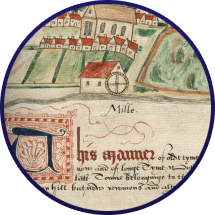Everyday Life in a Northumbrian Manor
All Manor of Things: An introduction to manors and their documents

Measurements
In the past, England used Imperial measurements, which date back to Roman times. In 1969, the UK replaced this with the metric system which was already being used in Europe. Therefore today, we use measurements of kilograms (kg), grams (g) and litres (l) instead of pounds (lb) and pints (pt) . However, the old measurements are still used – for example, beer and often milk is still measured in pints.
Often today, people still measure weights in pounds (lb) and height in feet (ft). Yet, in general, distances are more likely to be measured in metres (m), though miles (m) are still used for road distances. These quirks are worth noting, as the same inconsistencies can also be found in historic documents.
In this unit, we will focus on some measurements which are common in our manorial documents but not used today. Note that this is not an exhaustive list of historic measurements.
Acres, Roods and Perches
The most common measurement found in our manorial records is acres. These were used to measure areas of land and can still be found today. However, what may be less familiar is the sub division of acres – roods and perches – which are no longer used. Here’s a table of the old measurements.
A perch was a wooden measuring stick, used to measure the edges of land/fields and it was the smallest measurement used. Above this were roods and then acres. In documents, they will often be abbreviated to A. R. P., but can also be written out in full, see examples below:
“And also all that Plot or Parcel of Land containing 2 A 3 R 25 P.”
“Two Acres two Roods and five Perches”
These measurements can be found in surrenders and admissions and “intents to surrender” . Examples can be seen in the Hexham Manor section of transcripts on the website where the exact size of the land being surrendered had to be recorded.
Kennings and Pecks
These measurements relate to grain and are often found in manorial documents when tenants broke the rules on sowing or harvesting crops.
Here’s a table listing the words used and what they weighed:
It is common in manorial documents to find weight measurements in relation to grain, often where tenants have broken the rules on the sowing of crops or harvesting them. We do also find them in examples such as this one:
For the Matter in Plea Between Richard Steell plaintiffe
& Robert Lambert defendant being an action of debt for
a Bushall of Oat[es] The Jury doe finde that the defendant ij s
shall pay to the plaintiffe one kening of Oat[es] or two shilling[es]
in money & the Cost[es] of Court.
In this example, Robert Lambert was charged with debt, owing Richard Steell a bushel of oats. The jury ordered Lambert to pay Steell one kenning of oats (half a bushel) or to pay two shillings and the costs of court.
Heaped Measures and Beatments
These are very unusual measures but are found in our records, particularly in relation to markets where the manor customs define the measurements to be used.
Heaped measure – this was standardised by the 1824 Weights and Measures Act. From then a “heaped bushel” was the contents of a cone at least 6 inches tall!
Beatments – as a standard measure, this was a quarter of a peck, but in the example below, Hexham Manor is defining the exact size of this measurement to be used in their manor:
Here’s an example from the Hexham Manor Borough Books:
“We present that all Apples, Pears, Potatoes, Onions and such like
Fruit and Roots shall be measured by heap Measure and that
Beatments for measuring the same shall be four inches from
top to Bottom and that the half Beatment be two inches and
a half on pain of thirteen Shillings and four pence each and
everyone offending therein.”
Those not following this rule had to pay a hefty fine – thirteen shillings and 4 pence!
Scottish Measures
Although our manorial documents relate to England, it is worth remembering that Northumberland borders Scotland, and so Scottish weights can appear in our documents as well which can be confusing. Their measurements could weigh more/less than those in England!
For example, the Scottish measurement of “boll” can appear in the documents when measuring oats. If used as a measurement for oats, in 1661 this would equal 5 bushels 3 pecks 0.600 gallons or in metric 211.664 litres.
The majority of our manorial records use the English terms for measures, but it’s worth bearing this in mind.
Activity - Test your knowledge
- If a plot of land measures 8 roods and 84 perches, what would this be in A. R. P.?
- How many kennings are there in 6 bushels?
- If a plot of land measures 8 roods and 84 perches, what would this be in A. R. P.?
Answer: 2 Acres, 2 Roods, 4 Perches
- How many kennings are there in 6 bushels?
Answer: 12 kennings






